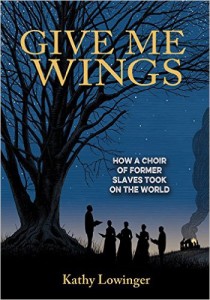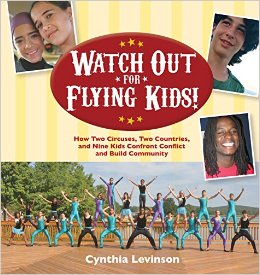When young people come together through the performing arts, the effects can be transformational. Working together, they see each other as equals, learn to trust each other, and learn about lives and experience beyond their own. The effects they have on their audiences can be transformational as well, when the performances challenge preconceptions and introduce new artistic genres.
Kathy Lowinger’s Give Me Wings: How a Choir of Former Slaves Took on the World (Annick Press, 2015) and Cynthia Levinson’s Watch Out for Flying Kids! How Two Circuses, Two Countries, and Nine Kids Confront Conflict and Build Community (Peachtree, 2015) explore the far-reaching impact of the performing arts past and present. From black singers performing for mostly white audiences in the United States after the Civil War to contemporary boys and girls, black and white, Arabs and Jews developing and performing circus acts, the authors offer inspirational stories of real people.
 Give Me Wings tells the story of the Jubilee Singers, formed in 1871 to raise money for Fisk University, a recently established black university in Nashville, Tennessee, threatened with bankruptcy. Ella Sheppard, born into slavery in Tennessee but whose father was able to purchase her freedom and move her to Ohio, is the focus of Lowinger’s book. Lowinger describes the challenges faced by Sheppard and the rest of the choir, ranging from small audiences that further drained finances to the lack of hotels and public facilities willing to accommodate the all-black singers on tour. At first, the classically trained Sheppard and her fellow singers received a lukewarm reception from white audiences who expected minstrel shows. Gradually, they began singing the songs that kept up their spirits during their time in slavery, much as they wanted to forget that period in their lives. The spirituals, though, appealed to audiences in the North and in England, and the message of freedom and survival represented a progressive, dignified alternative to the subordination and humiliation of the minstrel show.
Give Me Wings tells the story of the Jubilee Singers, formed in 1871 to raise money for Fisk University, a recently established black university in Nashville, Tennessee, threatened with bankruptcy. Ella Sheppard, born into slavery in Tennessee but whose father was able to purchase her freedom and move her to Ohio, is the focus of Lowinger’s book. Lowinger describes the challenges faced by Sheppard and the rest of the choir, ranging from small audiences that further drained finances to the lack of hotels and public facilities willing to accommodate the all-black singers on tour. At first, the classically trained Sheppard and her fellow singers received a lukewarm reception from white audiences who expected minstrel shows. Gradually, they began singing the songs that kept up their spirits during their time in slavery, much as they wanted to forget that period in their lives. The spirituals, though, appealed to audiences in the North and in England, and the message of freedom and survival represented a progressive, dignified alternative to the subordination and humiliation of the minstrel show.
Published in Canada, Give Me Wings contains more background information about slavery than may be necessary for readers in the United States, but Lowinger intersperses this context with stories from Sheppard’s life, beginning when, at the age of three, she was ordered to spy on her mother. Readers meet other singers with even more difficult lives, and they learn of the concerted efforts by white supremacists to destroy black schools and terrorize their teachers and students. Give Me Wings is a story of triumph, showing how a handful of dedicated and talented vocalists were able to save what is now one of the oldest historically black universities in the United States.
 The quality of the photography is the first thing one notices about Watch Out for Flying Kids! Colorful and engaging, it shows the diversity of the children and teens in St. Louis, Missouri, and the Galilee region of Israel. In alternating chapters, Levinson introduces the St. Louis Arches, a circus troupe now on its second generation of bringing black and white kids together to create polished, award-winning shows, and the Galilee Circus, a “social circus” with the aim of fostering peaceful interactions between Israeli Jews and Arabs. Through contact between St. Louis Arches director Jessica Hentoff and Galilee Circus founder Marc Rosenstein, the St. Louis youngsters first visited Israel in 2007, and in the next five years, there were several more visits back and forth. The Israeli youngsters were both impressed and intimidated by the relative professionalism of the St. Louis Arches, and it motivated them to take their circus work more seriously. For their part, the American youngsters noted the juggling skills of some of their Israeli counterparts and learned about life in the small Middle Eastern country.
The quality of the photography is the first thing one notices about Watch Out for Flying Kids! Colorful and engaging, it shows the diversity of the children and teens in St. Louis, Missouri, and the Galilee region of Israel. In alternating chapters, Levinson introduces the St. Louis Arches, a circus troupe now on its second generation of bringing black and white kids together to create polished, award-winning shows, and the Galilee Circus, a “social circus” with the aim of fostering peaceful interactions between Israeli Jews and Arabs. Through contact between St. Louis Arches director Jessica Hentoff and Galilee Circus founder Marc Rosenstein, the St. Louis youngsters first visited Israel in 2007, and in the next five years, there were several more visits back and forth. The Israeli youngsters were both impressed and intimidated by the relative professionalism of the St. Louis Arches, and it motivated them to take their circus work more seriously. For their part, the American youngsters noted the juggling skills of some of their Israeli counterparts and learned about life in the small Middle Eastern country.
Levinson doesn’t shy away from presenting the conflicts among the circus performers, some of them along racial and ethnic lines and others due to various personality conflicts. Some of the teens faced almost insurmountable challenges. One of the most talented performers was an African-American boy who witnessed his uncle’s murder and later struggled to stay out of academic and legal trouble. An Israeli Jewish boy discovered that he had more friends among Arabs because of his outspoken political views and inflexible personality. An Israeli Arab girl, an observant Muslim, had to adapt her routine because of her hijab and flowing, modest clothing. Readers get to know the children as they grow up over a period of nine years and become accomplished circus performers and citizens of the world.
Like Give Me Wings, Watch Out for Flying Kids! is an inspiring story of dedication to the arts and how it can bring about understanding and social change. Both books conclude with their principal figures passing the torch to a new generation.